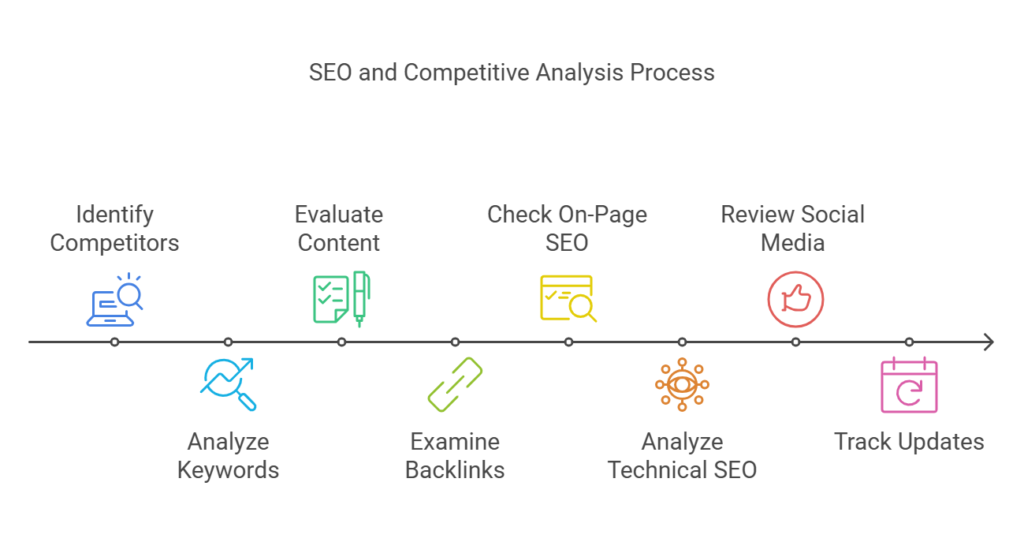Introduction
SEO Competitor Analysis Checklist is evaluating your competitors’ SEO strategies to identify strengths, weaknesses, and opportunities for your website. By understanding how competitors rank in search engines, you can develop a more practical approach to improve your visibility.
This analysis helps businesses discover what works in their industry, including high-performing keywords, content strategies, and backlink sources. It also highlights gaps that can be leveraged to gain a competitive edge.
SEO efforts can be directionless without competitor analysis, leading to wasted resources and missed ranking opportunities. By following a structured SEO Competitor Analysis Checklist, you can make informed decisions and enhance your search rankings efficiently.
Benefits of Conducting an SEO Competitor Analysis Checklist

Performing an SEO competitor analysis Checklist offers several key advantages that can improve your search rankings and overall digital strategy.
Identify Opportunities for Improvement
By analyzing competitors, you can find areas where your website falls short. This might include missing keywords, weak backlinks, or outdated content. Addressing these gaps helps enhance your SEO performance.
Understand Industry Trends and Benchmarks
Competitor analysis provides insight into current SEO trends in your industry. It helps you identify which strategies are working, such as content formats, keyword strategies, and backlink tactics, so you can align with or outperform competitors.
Develop Strategies to Outperform Competitors
Understanding what your competitors are doing allows you to refine your SEO approach. Whether improving content quality, optimizing technical SEO, or building stronger backlinks, you can implement targeted strategies to gain an edge in search rankings.
By leveraging these insights, businesses can stay competitive and continuously improve their SEO efforts.
Preparing for Competitor Analysis

Setting clear objectives and identifying the right competitors is essential before conducting an SEO competitor analysis. Proper preparation ensures that your study is focused and actionable.
Define Objectives
Clarify the goals of your competitor analysis. Are you looking to improve search rankings, find content gaps, or build a stronger backlink profile? Setting clear objectives helps guide your research and strategy.
Identify Competitors
Not all competitors are the same. Some directly compete for your customers, while others dominate search rankings without offering the same products or services. Categorize them into:
- Direct Competitors – Businesses that sell similar products or services to the same audience.
- Indirect Competitors – Websites ranking for the exact keywords but not necessarily selling the same products.
Use SEO Tools for Competitor Identification
To find your top SEO competitors, use tools like:
- SEMrush – Identifies website ranking for your target keywords.
- Ahrefs – Analyzes both organic search traffic and backlink profiles, providing insights into website performance and SEO strategies.
- Google Search Console – A quick way to see who ranks for your most important keywords.
Defining your goals and selecting the right competitors set the stage for a meaningful and effective SEO competitor analysis Checklist .
Data Collection Methods

Gathering accurate data is crucial for a practical SEO competitor analysis Checklist . This involves evaluating different aspects of a competitor’s website, content, keywords, backlinks, and technical SEO performance.
Website Analysis
Assess competitors’ site structure, navigation, and user experience (UX). A well-organized site with fast loading times and mobile-friendly design often ranks higher.
Content Evaluation
Analyze the type, depth, and frequency of content published. Identify top-performing blog posts, videos, and infographics that drive engagement and results. Determine how often they update content and what formats best engage their audience.
Keyword Analysis
Identify the keywords your competitors rank for using tools like Ahrefs or SEMrush. Pay attention to:
- High-volume keywords driving traffic
- Long-tail keywords with lower competition
- Keywords where competitors rank, but you don’t
Backlink Profile
Examine the number and quality of backlinks pointing to a competitor’s site. Backlinks from high-authority domains boost rankings. Identify link-building opportunities by finding websites that link to multiple competitors but not to you.
Technical SEO Audit
Check competitors’ site speed, mobile-friendliness, and core web vitals. Analyze structured data usage, XML sitemaps, and indexing issues that could impact rankings.
Social Media Presence
Evaluate how competitors leverage social media for SEO. Look at follower count, engagement levels, and the types of content they share. Social signals can indirectly influence rankings by driving traffic and brand awareness.
Collecting and analyzing this data provides the foundation for a well-informed SEO strategy, helping you identify opportunities to improve and outrank competitors.
Analyzing Competitor Strategies

Once you’ve gathered data, the next step is to analyze how competitors use SEO to achieve high rankings. This includes reviewing their on–page SEO, off-page SEO, content strategy, technical SEO, and user engagement metrics.
On-Page SEO
Examine how competitors optimize their pages for search engines by analyzing the following:
- Title Tags & Meta Descriptions – Are they keyword-rich and compelling?
- Header Tags (H1, H2, H3, etc.) – How do they structure content for readability and SEO?
- Keyword Usage – How naturally and frequently do they include keywords?
Off-Page SEO
Look at their backlink profile to assess the following:
- Backlink Quality – Are they earning links from high-authority websites?
- Anchor Text Diversity – Do they use a mix of branded, exact-match, and generic anchor texts?
- Domain Authority – Compare the overall strength of their website against yours.
Content Strategy
Determine what types of content perform best for competitors by analyzing the following:
- Content Formats – Do they focus on blogs, videos, infographics, or case studies?
- Posting Frequency – How often do they publish new content?
- Content Depth & Quality – Are their articles more detailed and informative than yours?
Technical SEO
Evaluate their technical performance, which can impact search rankings:
- Site Speed – Does their website load faster than yours?
- Mobile Optimization – Is their site mobile-friendly and responsive?
- Crawlability & Indexing – They use structured data, XML sitemaps, and proper indexing.
User Engagement Metrics
Engagement metrics help measure how users interact with their site. Look at:
- Bounce Rate – Are visitors staying on their site or leaving quickly?
- Time on Site – Do users spend more time engaging with their content?
- Pages Per Session – Is your content engaging enough for visitors to explore beyond the first page?
By analyzing these factors, you can identify what makes competitors successful and use those insights to refine your SEO strategy.
Identifying Opportunities and Gaps
After analyzing competitor strategies, the next step is to uncover gaps and opportunities that can give you a competitive edge. This involves identifying keyword gaps, content gaps, and backlink opportunities.
Keyword Gaps
Find high-value keywords that your competitors rank for, but you don’t. Use tools like Ahrefs or SEMrush to:
- Compare competitor keyword rankings with yours.
- Identify high-traffic keywords with lower competition.
- Discover long-tail keywords that can attract targeted visitors.
Content Gaps
Look for topics your competitors have covered that are missing from your website. Analyze:
- Blog posts and guides that drive high engagement.
- Popular content formats (videos, infographics, case studies).
- Evergreen topics that consistently generate traffic.
You can improve rankings and attract more visitors by filling these gaps with high-quality, optimized content.
Backlink Opportunities
Backlinks from authoritative sites improve rankings. To find link-building opportunities:
- Identify websites linking to competitors but not to you.
- Look for industry-specific directories, guest posting opportunities, and resource pages.
- Reach out to relevant sites with valuable content to earn backlinks.
By leveraging keyword, content, and backlink gaps, you can enhance your SEO strategy and outperform competitors in search rankings.
Developing an Actionable Strategy

Once you’ve identified gaps and opportunities, the next step is to create a strategy that helps you outperform competitors. This involves optimizing keywords, improving content, building backlinks, and fixing technical SEO issues.
Keyword Optimization
Use the keyword gaps you discovered to enhance your content strategy:
- Target high-value keywords competitors rank for, but you don’t.
- Optimize existing content with better keyword placement.
- Focus on long-tail keywords that attract specific audiences.
Content Development
Create high-quality, engaging content that fills the gaps left by competitors:
- Write in-depth blog posts, guides, and case studies.
- Incorporate diverse formats like videos, infographics, and podcasts.
- Align content with user intent to improve engagement and rankings.
Link Building
Strengthen your website’s authority by acquiring quality backlinks:
- Reach out to sites that link to competitors but not to you.
- Publish guest posts on industry-related websites.
- Create link-worthy content, such as original research or expert roundups.
Technical Improvements
Ensure your website is technically sound for better rankings:
- Improve site speed and mobile responsiveness.
- Fix crawl errors, broken links, and duplicate content.
- Implement structured data to enhance search visibility.
Executing these steps can help you build a stronger SEO strategy, improve search rankings, and stay ahead of competitors.
Monitoring and Continuous Improvement
SEO is an ongoing process; regular monitoring ensures your strategies remain effective. You can stay ahead of competitors by tracking performance and making necessary adjustments.
Performance Tracking
Use analytics tools to measure the impact of your SEO efforts:
- Google Analytics – helps monitor organic traffic, analyze user behavior, and measure conversions, providing valuable insights into website performance and user interactions.
- Google Search Console – allows you to track keyword rankings, monitor impressions, and analyze click-through rates, providing valuable insights into your website’s search performance and user engagement.
- SEMrush or Ahrefs – Analyze backlink growth, keyword performance, and competitor rankings.
Regular Audits
Schedule periodic SEO audits to identify new opportunities and fix issues:
- Conduct content audits to update outdated information.
- Review backlink profiles to remove toxic links.
- Optimize technical SEO elements like page speed, mobile-friendliness, and structured data.
Adapting to SEO Changes
SEO trends and algorithms constantly evolve. Stay updated by:
- Following industry blogs like Moz, Search Engine Journal, and Google’s official updates.
- Testing new SEO tactics and analyzing results.
- Adjusting strategies based on competitor movements and market trends.
By continuously monitoring and refining your SEO efforts, you can maintain strong rankings and outperform competitors in the long run.
Tools and Resources
Using the right SEO tools and learning resources can improve the efficiency and accuracy of your SEO competitor analysis checklist. Here are some essential tools and educational sources to help you stay ahead.
SEO Tools
These tools assist with various aspects of competitor analysis:
- SEMrush – Keyword research, competitor tracking, and backlink analysis.
- Ahrefs – In-depth backlink audits and keyword gap analysis.
- Moz – Domain authority insights and keyword research.
- Screaming Frog – Technical SEO audits, including crawl errors and site structure analysis.
- Google Search Console – Tracks search performance and indexing issues.
Learning Resources
Stay updated with SEO best practices through these sources:
- Moz Blog – Guides and updates on SEO trends.
- Search Engine Journal – Expert insights and case studies.
- Google Search Central Blog – Official updates on Google’s ranking algorithms.
- Ahrefs Academy – Free courses on SEO and digital marketing.
By leveraging these tools and resources, you can conduct a thorough SEO competitor analysis checklist and continuously improve your search rankings.
Case Studies and Examples
Real-world examples of successful SEO competitor analysis can provide valuable insights into how businesses improve search rankings. By studying these cases, you can learn practical strategies to apply to your SEO efforts.
Success Stories
Many companies have used competitor analysis to boost their SEO performance. For example:
- An eCommerce store identified keyword gaps and optimized product pages, increasing organic traffic by 40%.
- A SaaS company analyzed competitors’ backlink profiles and earned high-authority links, improving domain authority and rankings.
- A local business improved local SEO by studying top-ranking competitors’ Google My Business strategies and customer engagement.
Templates for SEO Competitor Analysis
To make your analysis more structured, use pre-built templates:
- Keyword Gap Analysis Template – Compare your rankings with competitors.
- Backlink Tracking Sheet – Monitor competitor backlinks and outreach efforts.
- Content Audit Checklist – Identify missing or underperforming content areas.
By applying insights from successful case studies and using structured templates, you can develop a more effective and organized SEO strategy.
Conclusion
To recap:

- Find competitors using tools and keyword searches.
- Analyze their keywords to uncover gaps and opportunities.
- Evaluate their content for quality, format, and engagement.
- Examine backlinks to build your link-building plan.
- Check on-page SEO for title tags, headers, and internal links.
- Analyze technical SEO factors such as website speed, mobile responsiveness, and proper indexing.
- Review social media to understand their engagement tactics.
- Track updates regularly to stay informed about new trends and changes.
Frequently Asked Questions (FAQs)
1. How often should I conduct an SEO competitor analysis?
It’s best to perform a competitor analysis every 3–6 months. However, you should monitor keyword rankings, backlinks, and content performance monthly to stay ahead of changes.
2. What’s the best tool for SEO competitor analysis?
There’s no best tool, but SEMrush, Ahrefs, and Moz are widely used for keyword research, backlink tracking, and competitive analysis. Google Search Console and Google Analytics are essential for monitoring your SEO performance.
3. How do I find my actual SEO competitors?
Your SEO competitors are websites that rank for the exact keywords you want, even if they don’t sell the same products or services. Use Google search, Ahrefs’ Site Explorer, or SEMrush’s Competitive Research Tool to identify them.
4. How can I outrank my competitors?
Focus on creating better, more informative content, optimizing on-page SEO, earning high-quality backlinks, and improving technical SEO factors like page speed and mobile-friendliness.
5. Why is backlink analysis critical in SEO competitor research?
Backlinks signal authority to search engines. By analyzing competitors’ backlink profiles, you can find opportunities to earn links from the same high-quality sources and boost your rankings.
6. Can small businesses compete with large companies in SEO?
Yes, small businesses can compete effectively by targeting niche keywords, creating high-value content, and building a strong local SEO presence, even against more prominent brands.
By consistently applying the SEO Competitor Analysis Checklist, businesses can refine their SEO strategies and gain a competitive advantage in search rankings.








4 Responses
Excellent points! Thanks for sharing your knowledge.
Thank You
I got good info from your blog
Very good blog post. I certainly love this site.
Stick with it!